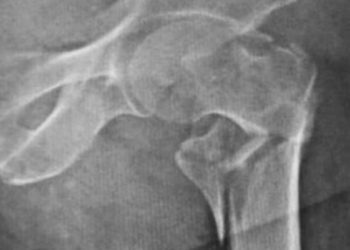Fracture severity associated with treatment invasiveness for distal radius fractures
Image: CC/Wiki L. Monfils
1. For patients with displaced intra-articular distal radius fractures, as fracture severity increased, more invasive procedures were appropriately chosen to produce adequate bony alignment.
2. At one year post-treatment, patient rated wrist evaluation (PRWE) scores were higher (worse) in patients with more invasive treatments. This trend mirrored the severity of the fracture that the patient presented with.
Evidence Rating Level: 2 (Good)
Study Rundown: Distal radius fractures, classically the result a fall on outstretched hands, are a common orthopaedic injury. Fractures that extend into the wrist joint are termed “intra-articular” and pose increased risk of morbidity and complications such as arthritis, pain, and non-union. There are a wide variety of treatment options that range from casting to surgical interventions such as open reduction and internal fixation (ORIF). To date, there is insufficient data on which fixation technique is best for treating displaced intra-articular distal radius fractures.
The current study compared five treatment options by examining functional and radiographic measures pre-operatively and then one year after treatment. Treatment groups included the following 1) Cast only 2) Closed reduction plus pins 3) Closed reduction plus external fixation (Ex-Fix) 4) ORIF 5) ORIF plus Ex-Fix. Prior to treatment, radiographic measures such as volar tilt or intra-articular step-off were significantly different between treatment groups. By contrast, no significant difference was found following treatment, indicating that each treatment option was successful in producing the desired bony alignment. Patient rated wrist evaluation (PRWE) scores were statistically significantly different across groups (p=0.027) with higher (worse) scores correlating with increased invasiveness of treatment. Worse scores are likely secondary to more severe injuries rather than a demerit of the treatment.
This study was limited by its observational nature and small subgroup sizes which preclude the ability to compare or differentiate treatment effectiveness. The ORIF technique was also inconsistent with both volar and dorsal plating used. Dorsal plating may produce worse outcomes, which could bias this study against ORIF. Despite its shortcomings, this study highlights the multitude of treatment options for intra-articular distal radius fractures and provides reassurance that more invasive treatments do provide desired bony alignment despite more severe presentation.
Click to read the study, published today in HAND
Relevant Reading: Management of distal radial fractures
In-Depth [cohort study]: This study examined 148 consecutive patients with intra-articular distal radius fractures recruited at a single institution from 2003 to 2008. Average patient age was 47 years (range 44-54) with 60 male and 88 female. Patients were treated by a group of fellowship-trained hand surgeons with treatment determined on a case by case basis. Functional outcomes were measured via the PRWE, the SF-36, and wrist outcome measures (WOM), which include grip strength, range of motion, and wrist rotation. Radiographic measures of radial inclination, dorsal angulation, and radial shortening were analyzed and the McMurtry classification system was used to classify the intra-articular fractures based on severity of the fracture and amount of comminution. Radiographic and functional measures were evaluated at initial presentation and again at 1 year post-treatment.
Clinical functional measures mirrored severity at presentation with both PRWE (p=0.027) and WOM (p=0.005) demonstrating statistical difference between treatment groups at one year. Each radiographic measure demonstrated significant difference between treatment groups prior to treatment: intra-articular step-off(p=0.007), volar tilt (p=0.002), radial shortening (p=0.001), and radial inclination(p=0.001). Radiographic significance disappeared at one year, signifying a common outcome.
More from this author: Tendon transfer improves ankle function and reduces pain for chronic achilles tendinosis, Open carpal tunnel release provides long-term symptom relief, 4 million living with total knee replacement (TKR): First estimates of TKR burden in the US, Treating proximal humeral fractures: Reverse shoulder arthroplasty provides superior long term functional outcomes vs. hemiarthroplasty, Treating displaced femoral neck fractures: total hip arthroplasty (THA) found superior to open-reduction internal fixation (ORIF)
©2012-2014 2minutemedicine.com. All rights reserved. No works may be reproduced without expressed written consent from 2minutemedicine.com. Disclaimer: We present factual information directly from peer reviewed medical journals. No post should be construed as medical advice and is not intended as such by the authors, editors, staff or by 2minutemedicine.com. PLEASE SEE A HEALTHCARE PROVIDER IN YOUR AREA IF YOU SEEK MEDICAL ADVICE OF ANY SORT.








